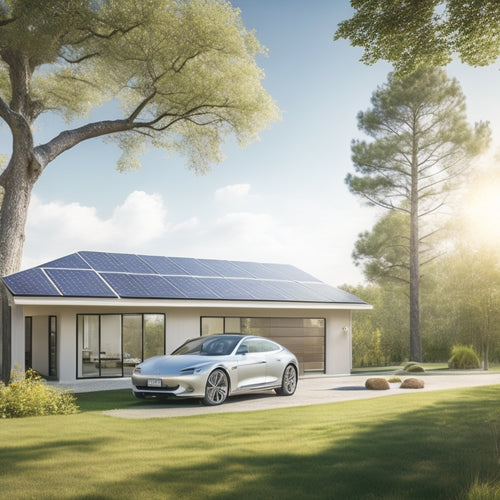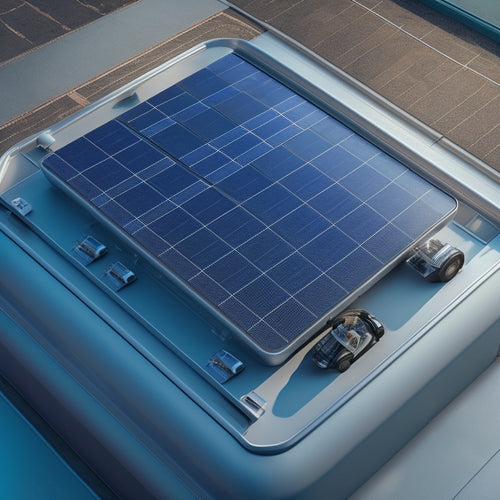
How Much Do Hidden Costs Affect the Cost of Installing Solar Panels
Share
When calculating the total cost of installing solar panels, you need to factor in hidden costs that can increase the overall installation cost by 10% to 20% or more. These include labor costs, permits and inspection fees, roof condition assessments, energy storage system costs, inverter replacement costs, monitoring and maintenance fees, utility connection charges, and warranty and insurance costs. Each of these components contributes to the final bill, and understanding their impact is vital for budgeting and planning. As you investigate the complexities of solar panel installation, you'll uncover more subtleties that influence the overall cost, and an all-encompassing view will emerge.
Key Takeaways
- Hidden labor costs can account for up to 10% of the total installation cost, depending on the complexity of the project and regional labor rates.
- Permits and inspection fees can add $1,000 to $3,000 to the total cost, varying by location and jurisdiction.
- Roof condition assessment and potential repairs can add significant costs, especially for older or damaged roofs.
- Inverter replacement costs, typically ranging from $1,000 to $5,000, can be a significant hidden expense during the system's lifespan.
- Ongoing monitoring and maintenance fees, although necessary, can add $500 to $2,000 per year to the overall cost of owning a solar panel system.
Understanding Solar Panel Pricing
When contemplating solar panel installation, one of the most critical factors to grasp is the pricing structure. You'll want to understand how the costs are broken down and what you can expect to pay upfront. The total cost of installation includes the solar panels themselves, inverters, mounting hardware, and installation labor.
Additionally, you should factor in installation financing options, such as loans or power purchase agreements, which can affect your overall costs. On the other hand, you may be eligible for solar incentives, like the federal solar investment tax credit, which can greatly reduce your expenses. These incentives can vary by location, so it's crucial to research what's available in your area.
To get an accurate estimate, you'll need to take into account the size of your solar panel system, the quality of the equipment, and the complexity of the installation.
Be sure to ask potential installers about their pricing structure and what's included in the total cost. By understanding the pricing factors, you can make an informed decision about your solar panel investment.
Hidden Costs of Installation Labor
You've secured a quote for your solar panel installation, but have you accounted for the labor costs that can add up quickly?
Labor rates vary depending on the region, contractor selection, and installation complexity. A skilled workforce with specialized training requirements can command higher rates, especially for complex installations that require more time and proficiency.
The project duration also plays a significant role in labor costs. A longer installation period means more labor hours, which translates to higher costs.
Additionally, regional variations in labor agreements and regulations can impact labor costs. For instance, unionized labor markets may have higher labor rates than non-unionized markets.
When selecting a contractor, it's crucial to evaluate their labor costs and how they impact the overall installation expense.
Be sure to ask about their labor rates, training requirements, and project duration to get a clear understanding of the total cost.
Permits and Inspection Fees
Secure necessary permits and undergo inspections to confirm your solar panel installation meets local building codes and regulations. This step is vital to ascertain your system is installed correctly and safely. You'll need to submit a permit application to your local government, which will review your plans and conduct inspections at various stages of the installation process.
| Permit/Inspection | Timeline |
|---|---|
| Building permit | 1-2 weeks |
| Electrical permit | 1-2 weeks |
| Final inspection | 1-3 days |
The permit application process typically takes 1-2 weeks, and you'll need to pay a fee, which varies by location. Inspection timelines also vary, but you can expect the final inspection to occur within 1-3 days of completing the installation. Be prepared to pay additional fees for any necessary re-inspections. Factor these costs into your overall budget to avoid surprise expenses. By understanding the permit and inspection process, you can better plan your solar panel installation and guarantee a smooth, stress-free experience.
Roof Repair and Replacement
When you're preparing your roof for solar panel installation, you'll need to assess its condition to identify potential issues.
If your roof is old or damaged, you may need to repair or replace it before installation, which can add significant costs to your project.
A thorough roof condition assessment will help you determine if repairs are necessary, and what those repairs will entail.
Roof Condition Assessment
Evaluating your roof's condition is an essential step in the solar panel installation process, as it can greatly affect the overall cost and timeline of the project.
You'll want to assess the age, material, and overall state of your roof to determine if it's suitable for solar panel installation. Different roof material types, such as asphalt shingles, metal, or clay tiles, have varying lifespans and requirements. For instance, asphalt shingles typically need to be replaced every 20-30 years, while metal roofs can last up to 50 years.
The installation timing is also vital, as installing solar panels on a new roof can be more cost-effective than doing so on an older roof that may need replacement soon.
A thorough roof condition assessment will help you identify potential issues and plan accordingly. This assessment may involve inspecting your roof's structure, checking for damaged or missing shingles, and evaluating its overall integrity.
Damaged Roof Repair
Your roof's condition assessment may uncover damage that requires repair or replacement before installing solar panels. This is vital to guarantee the solar panels are installed on a sturdy and watertight roof. Roof leaks, for instance, can lead to water damage, electrical issues, and even fires.
| Roof Damage Type | Repair/Replacement Cost | Installation Timing Impact |
|---|---|---|
| Minor repairs (e.g., patching holes) | $500-$2,000 | Minimal delay (1-2 weeks) |
| Moderate repairs (e.g., replacing shingles) | $2,000-$5,000 | Moderate delay (2-4 weeks) |
| Major repairs/replacement | $5,000-$15,000+ | Significant delay (4-12 weeks or more) |
The cost of damaged roof repair can vary widely, as shown in the table above. The extent of the damage will influence the repair or replacement cost, which, in turn, affects the installation timing. It is important to factor these costs into your overall solar panel installation budget to avoid surprises down the line.
Energy Storage System Costs
The energy storage system (ESS) is an integral component of your solar panel installation, allowing you to store excess energy generated during the day for use during the night or on cloudy days.
When planning your ESS, you'll want to take into account battery efficiency, system compatibility, and capacity planning to guarantee you're getting the most out of your system. With an ESS, you'll gain energy independence and be able to integrate with the grid, reducing your reliance on traditional energy sources.
The timing of your ESS installation is also vital, as it can impact the overall cost of your solar panel installation.
Fortunately, technology advancements have made ESS more affordable, and financial incentives are available to help offset the cost. By investing in an ESS, you'll not only reduce your environmental impact but also enjoy long-term savings on your energy bills.
As you weigh the costs and benefits of an ESS, reflect on how it can help you achieve your energy goals and contribute to a more sustainable future.
Inverter Replacement Costs
When you install solar panels, you expect them to last for decades, but the inverters that convert DC power to AC power don't have the same lifespan.
Typically, inverters last around 10 to 15 years, which means you'll likely need to replace them at least once during the solar panel system's 25-year warranty period.
If your inverter fails, you'll face not only the replacement cost but also lost energy production and potential roof access issues, which can add up quickly.
Inverter Lifespan Expectations
About every 10 to 15 years, you can expect to replace your solar panel system's inverter, an essential component that converts DC power into usable AC power for your home.
This replacement cost is a significant hidden expense that should be factored into your overall solar panel system budget. Fortunately, advancements in inverter technology have led to more efficient and reliable systems.
Here are some key considerations to keep in mind when evaluating inverter lifespan expectations:
-
Inverter efficiency ratings: Look for inverters with high efficiency ratings to minimize energy losses and maximize your solar panel system's output.
-
Inverter quality and durability: Invest in high-quality inverters from reputable manufacturers to guarantee a longer lifespan.
-
Environmental factors: Extreme temperatures, humidity, and exposure to nature can affect inverter lifespan, so consider these factors when selecting an inverter.
- Warranty and maintenance: Check the warranty offered by the manufacturer and the maintenance requirements to guarantee you're prepared for any issues that may arise.
Inverter Failure Consequences
Concurrently with your solar panel system's energy production, you should prepare for the inevitable inverter failure, which can occur suddenly or gradually, leaving you with costly replacement expenses.
When an inverter fails, it can markedly impact your energy output and revenue. You'll need to evaluate the cost of replacing the inverter, which can range from $1,000 to $5,000 or more, depending on the inverter type, efficiency, and technology.
Inverter brands and models vary in their reliability and durability, affecting their lifespan and failure rates. Improper inverter placement, inadequate safety measures, and poor maintenance can also contribute to premature failure.
Additionally, inverter upgrades or changes may require reconfiguration, adding to the overall cost. Inverter compatibility issues with other system components can also lead to additional expenses.
It's crucial to review inverter warranties and assess extended warranty options to mitigate these costs. Understanding inverter failure consequences will help you plan and budget for these unexpected expenses, ensuring your solar panel system's long-term performance and ROI.
Monitoring and Maintenance Fees
Your solar panel system's monitoring and maintenance needs are ongoing, and so are the associated costs. These expenses can add up quickly, so it's vital to factor them into your overall cost analysis.
You'll need to take into account the following fees:
-
Monitoring technology costs: You'll need to invest in a monitoring system to track your solar panel system's performance. This technology allows for remote monitoring and performance tracking, guaranteeing your system is running at its best.
-
Maintenance schedules: Regular maintenance is important to extending the lifespan of your solar panel system. You'll need to budget for routine inspections, cleaning, and repairs, which can be included in a service agreement with your installer.
-
Technician availability: In the event of an issue, you'll need access to a technician to diagnose and repair the problem. This can be a costly expense, especially if you have a complex system.
- Software updates: As monitoring technology advances, you'll need to stay up-to-date with the latest software updates to make sure your system remains compatible and efficient.
Utility Connection Charges
Reliability is key when it comes to utilizing solar power, and a crucial aspect of this reliability is ensuring a seamless connection to the utility grid.
As you consider installing solar panels, you'll need to factor in utility connection charges, which can add up quickly. These charges typically include service fees for the utility company to review and approve your grid connection application. You may also need to pay for connection upgrades, such as infrastructure improvements to support the increased energy flow.
Before installing your solar panels, you'll need to sign an interconnection agreement with your utility company, which outlines the terms of your grid connection.
While utility incentives can help offset some of these costs, it's important to factor them into your overall installation timeline and financing options. Be sure to ask your solar installer about these charges upfront to avoid surprises down the line.
Warranty and Insurance Costs
As you steer through the process of installing solar panels, contemplating warranty and insurance costs becomes essential in ensuring long-term financial protection.
You'll want to understand the types of warranty coverage and insurance options available to protect your investment.
When it comes to warranty coverage, you'll typically have two options:
-
Manufacturer's warranty: Covers defects in materials and workmanship for a specified period, usually 10-25 years.
-
Installer's warranty: Covers labor and workmanship for a specified period, usually 1-10 years.
In addition to warranty coverage, you'll also want to reflect on insurance types to protect your solar panel system from unforeseen events.
These may include:
-
Property insurance: Covers damage to your solar panel system from natural disasters, theft, or vandalism.
-
Performance insurance: Covers losses in energy production due to equipment failure or other issues.
Frequently Asked Questions
Can I Install Solar Panels on a Metal or Clay Tile Roof?
You can install solar panels on a metal or clay tile roof, but you'll need to guarantee metal roof compatibility and consider clay tile considerations, such as added weight and potential waterproofing issues, before proceeding with your solar installation.
Do Solar Panels Increase My Property Tax Bill?
Will going green really cost you more in the long run? Not necessarily - you'll likely avoid increased property tax bills, thanks to solar panel exemptions that shield your investment from property tax implications, ensuring your wallet stays happy.
Can I Install Solar Panels on a Rented Property?
You'll need to review your rental agreements and understand your tenant rights before installing solar panels on a rented property, as you'll require your landlord's consent and may need to negotiate a longer lease or rent increase.
Are There Any Solar Panel Installation Financing Options Available?
Ha! You thought going solar would break the bank? Think again! You've got options: solar loans for homeowners, lease agreements for renters, and even government-backed financing to make your eco-friendly dreams a reality, without draining your wallet.
How Long Does a Typical Solar Panel Installation Project Take?
You'll typically experience a multi-phase installation timeline, spanning 2-6 months, where project phases include assessment, design, permitting, installation, inspection, and activation, with your solar panel installation project taking around 3-5 days for the actual installation process.
Conclusion
As you traverse the process of installing solar panels, remember that hidden costs can be the unseen anchors burdening your investment. Just as a ship can't reach its full speed with anchors holding it back, your solar panel system can't reach its full potential without considering these often-overlooked expenses. Factor in labor, permits, roof repairs, energy storage, inverter replacement, monitoring, utility connection, and warranty costs to ascertain a smooth and profitable expedition to renewable energy.
Related Posts
-

Why Invest in Solar Car Battery Chargers Online?
By investing in a solar car battery charger online, you're not only reducing your reliance on fossil fuels but also o...
-

Top Solar Panels for Car Battery Maintenance
When selecting top solar panels for car battery maintenance, consider high-efficiency models with high wattage output...
-

Planning for an Electric Vehicle-Friendly Urban Future
As you plan for an electric vehicle-friendly urban future, you'll need to integrate high-power charging stations, sma...


